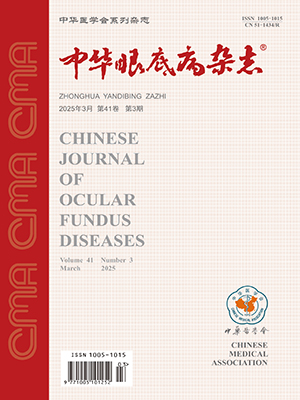| 1. |
Zhang SQ, Jiang T, Li M, et al. Exome sequencing identifies MVK mutations in disseminated superficial actinic porokeratosis[J]. Nat Genet, 2012, 44(10): 1156-1160. DOI: 10.1038/ng.2409.
|
| 2. |
Wang P, Guo X, Zhang Q. Further evidence of autosomal-dominant Leber congenital amaurosis caused by heterozygous CRX mutation[J]. Graefe's Arch Clin Exp Ophthalmol, 2007, 245(9): 1401-1402. DOI: 10.1007/s00417-007-0554-0.
|
| 3. |
den Hollander AI, Roepman R, Koenekoop RK, et al. Leber congenital amaurosis: genes, proteins and disease mechanisms[J]. Prog Retin Eye Res, 2008, 27(4): 391-419. DOI: 10.1016/j.preteyeres.2008.05.003.
|
| 4. |
Schlessinger A, Yachdav G, Rost B. PROFbval: predict flexible and rigid residues in proteins[J]. Bioinformatics, 2006, 22(7): 891-893. DOI: 10.1093/bioinformatics/btl032.
|
| 5. |
Wang H, Wang X, Zou X, et al. Comprehensive molecular diagnosis of a large Chinese Leber congenital amaurosis cohort[J]. Invest Ophthalmol Vis Sci, 2015, 56(6): 3642-3655. DOI: 10.1167/iovs.14-15972.
|
| 6. |
Li L, Xiao X, Li S, et al. Detection of variants in 15 genes in 87 unrelated Chinese patients with Leber congenital amaurosis[J/OL]. PLoS One, 2011, 6(5): e19458[2011-05-13]. https://doi.org/10.1371/journal.pone.0019458. DOI: 10.1371/journal.pone.0019458.
|
| 7. |
Ullah I, Kabir F, Iqbal M, et al. Pathogenic mutations in TULP1 responsible for retinitis pigmentosa identified in consanguineous familial cases[J]. Mol Vis, 2016, 22: 797-815.
|
| 8. |
Kondo H, Qin M, Mizota A, et al. A homozygosity-based search for mutations in patients with autosomal recessive retinitis pigmentosa, using microsatellite markers[J]. Invest Ophthalmol Vis Sci, 2004, 45(12): 4433-4439. DOI: 10.1167/iovs.04-0544.
|
| 9. |
Hagstrom SA, Watson RF, Pauer GJ, et al. Tulp1 is involved in specific photoreceptor protein transport pathways[J]. Adv Exp Med Biol, 2012, 723: 783-789. DOI: 10.1007/978-1-4614-0631-0_100.
|
| 10. |
Grossman GH, Pauer GJ, Narendra U, et al. Early synaptic defects in tulp1-/- mice[J]. Invest Ophthalmol Vis Sci, 2009, 50(7): 3074-3083. DOI: 10.1167/iovs.08-3190.
|
| 11. |
Hosch J, Lorenz B, Stieger K. RPGR: role in the photoreceptor cilium, human retinal disease, and gene therapy[J]. Ophthalmic Genet, 2011, 32(1): 1-11. DOI: 10.3109/13816810.2010.535889.
|
| 12. |
Khan AO, Abu-Safieh L, Eisenberger T, et al. The RPGRIP1-related retinal phenotype in children[J]. Br J Ophthalmol, 2013, 97(6): 760-764. DOI: 10.1136/bjophthalmol-2012-303050.
|
| 13. |
Chen Y, Zhang Q, Shen T, et al. Comprehensive mutation analysis by whole-exome sequencing in 41 Chinese families with Leber congenital amaurosis[J]. Invest Ophthalmol Vis Sci, 2013, 54(6): 4351-4357. DOI: 10.1167/iovs.13-11606.
|
| 14. |
王淑然. Leber先天性黑矇致病基因及相关临床表型研究进展[J]. 中华实验眼科杂志, 2013, 31(12): 1178-1182. DOI: 10.3760/cma.j.issn.2095-0160.2013.12.018.Wang SR. Current advance in genetics and clinical phenotype of Leber congenital amaurosis[J]. Chin J Exp Ophthalmol, 2013, 31(12): 1178-1182. DOI: 10.3760/cma.j.issn.2095-0160.2013.12.018.
|
| 15. |
Eisenberger T, Neuhaus C, Khan AO, et al. Increasing the yield in targeted next-generation sequencing by implicating CNV analysis, non-coding exons and the overall variant load: the example of retinal dystrophies[J/OL]. PLoS One, 2013, 8(11): e78496[2013-11-12]. https://doi.org/10.1371/journal.pone.0078496. DOI: 10.1371/journal.pone.0078496.
|





 Baidu Scholar
Baidu Scholar